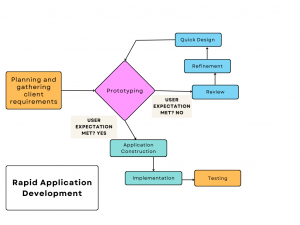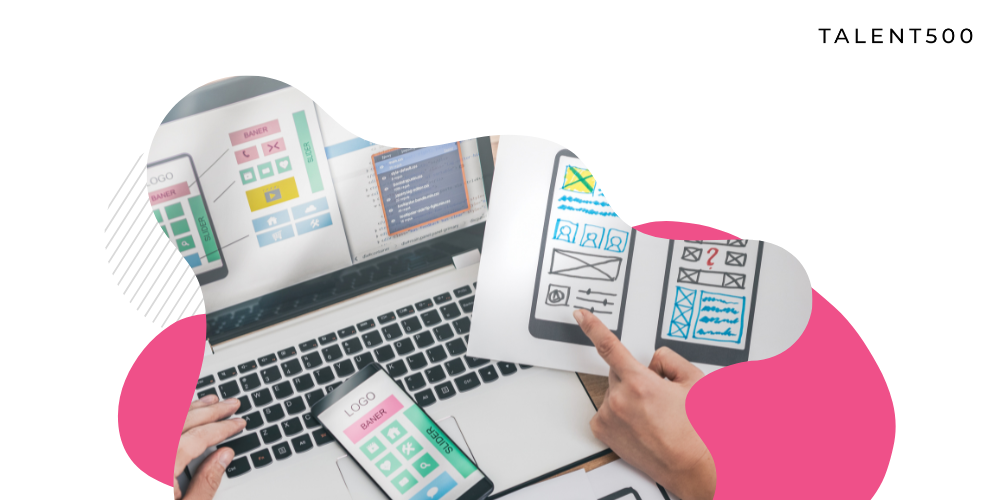Rapid Application Development (RAD) is the process of creating software solutions in a short amount of time through rapid iteration. This model requires that you take advantage of the feedback loop provided by rapid feedback. You can maintain a high degree of transparency with your users, stakeholders and relevant teams.
What is Rapid Application Development Model (RAD)?
Rapid application development (RAD) model of software development involves rapid prototyping and testing, using an iterative process. The term “rapid” refers to the speed at which a project can be developed, which means it can be created quickly and then tested quickly.
Rapid application development model can be defined through following components:
- Conceptualization phase: This involves defining the problem that needs solving and creating a rough prototype that represents what the final product will look like. It also includes gathering requirements from stakeholders in order to make sure those requirements are met when designing the initial prototype.
- Rapid prototyping: This involves creating an initial version of a solution based on the requirements gathered during the conceptualization phase and sharing it with stakeholders for feedback before proceeding with further development. This involves creating wireframes and mockups using tools like Axure or Balsamiq Mockups.
- Quick feedback: This involves getting feedback from stakeholders about the prototype in order to ensure that it meets their needs before moving forward with further development.
Advantages of Rapid Application Development

Image text: Rapid Application Development benefits
Rapid Application Development (RAD) benefits involves the following:
- Faster delivery of applications: With RAD approach developers can work on multiple, independent software “prototypes” simultaneously. These all get integrated into a final product at the end.
- Increased productivity: Rapid application development allows developers to focus on their primary areas of functionality requirements from customers, rather than spending time learning new processes and tools. This means that you can develop your applications more quickly and make them more effective for your customers.
- Improved quality of software: Rapid application development allows you to experiment with new ideas or concepts without the potential for costly mistakes or delays. The final product will likely be better than what would have been produced under normal circumstances, making it worth the investment.
- Improved user satisfaction: Rapid application development involves a continuous iterative process without any strict milestones or deadlines. It relies on constant feedback from clients and stakeholders to evolve toward a finished product.
- Enhanced risk management: Helps in creating prototypes quickly, which can be used for testing purposes before launching the final product.
Rapid Application Development disadvantages and drawbacks

Image text: Rapid Application Development benefits
RAD is not for every company and project. It has certain limitations, but it can be applied effectively to some situations. The drawbacks include:
- Requirement of more resources to develop your application.
- RAD requires a lot of documentation and planning before you begin working on your software application.
- It also requires highly skilled designers, developers, and coders who understand their role in the process as well as what needs to be done at each stage of development.
- Because RAD takes time to develop an application from scratch (or even modify an existing one), it may not be ideal for smaller projects or when your technical risk is high.
What is the process for Rapid Application Development?

Image text: Rapid Application Development flowchart (RAD process)
Business Planning and Modeling
Business modeling provides a high-level overview of an organization’s business, including its customers, products, services, and markets. Business modeling also includes a description of the organization’s resources and capabilities.
This is particularly important for organizations that are considering rapid application development (RAD), as they can use this information to determine what will be needed to support their RAD projects.
The following are some steps involved in business modeling:
- Define requirements: identify what needs to be done and how it should be done
- Identify stakeholders: make sure people who will be affected by your business model understand its requirements and impacts
- Develop scenarios: consider various scenarios that may occur during implementation of your business model.
Prototype Construction and User Design
In the prototype construction phase of the rapid application development (RAD) model, users are typically involved in the prototype construction. This involves the product designing that’s intended to solve a problem for users. The problem can be real or imagined, but it needs to be clear and focused enough that it can be solved by a prototype.
Prototype construction involves two stages: user design and technical design.
- User design involves understanding what users want from their product and then coming up with an initial solution to meet those needs.
- Technical design involves coming up with a solution for how to actually create that product. Technical design includes creating mock-ups of how the product will look on different devices or platforms, as well as creating plans for how to build it in different ways.
Designing And Prototype Assembly
- This involves writing code that can be used to assemble the prototype into a working system.
- The coding phase involves writing code for each feature and testing it out in an environment similar to what will be used by users.
- The assembly phase involves assembling all of the pieces together into one cohesive product that can be used by users.
- This coding process allows for developers to focus on assembling and testing out the code, rather than building it from scratch.
- The final step is assembling prototypes together to test them for performance.
Prototype Testing
Testing is conducted after the prototype has been built in order for testers to evaluate whether or not it meets their needs for functionality and performance as well as usability issues during testing.
There are different types of testing in RAD:
- Functional testing. This type of testing is used to check whether all basic functionality has been implemented correctly. For example, if a user can log into their account, make purchases and view their orders, then this would be considered functional testing.
- Usability testing. Usability tests focus on how easy it is for users to interact with your product. They may include live user groups or user-testing sessions where you present your prototype to real people in a controlled environment and get feedback from them about how it works for them or doesn’t work at all!
- User experience testing (UX). UX tests look at every aspect of how users interact with your product including its visual design, navigation mechanics and overall user experience (UX).
- Compatibility testing: This type of test ensures that your product will work with other applications or devices on a platform (or platforms), such as software programs or mobile phones.
Rapid Application Development vs. Agile
Both Rapid Application Development framework and Agile Methodology enable software developers to develop and deploy quality apps and software quickly. However, both techniques have certain differences.
| Rapid Application Development | Agile |
| Rapid application development is a software development methodology that follows a continuous iteration process. It enables developers to respond to customer feedback and requests during the prototype development process. | Agile is an incremental approach to software development, which focuses on delivering products in short cycles with frequent releases, called “sprint” or “iteration”. This model requires self-managing teams that build working products every few weeks while constantly adapting them based on user needs and feedback from customers. |
| Rapid application development does not recommend any specific timeframe for providing deliverables. | Agile suggests having frequent milestones where you can show your progress toward completion by showing prototypes of what’s been completed so far (called “user stories”). |
| Different parts of prototypes are built and then assembled for developing an application. | Different parts of software are built and then assembled together. |
When should you use Rapid Application Development?
There are many scenarios in which you may decide to use Rapid Application Development. Some of these include:
- When you are working in a fast-paced environment and need to produce high quality software within a short period of time
- When your requirements are changing constantly, so as not to provide outdated information or information that is irrelevant at any given moment. This can be especially true if there is regular development happening within the organization itself.
- When you’ve a flexible budget and have the financial liberty to hire essential developers and tools for RAD.
Best tools for Rapid Application Development
RAD tools differ from traditional software development in that they do not require the time and expertise of a software developer. They also come with an added level of flexibility since they can be used on multiple platforms including mobile devices and desktops.
The following are some of the best RAD tools available on the market today:
- Kissflow: Kissflow is an all-in-one open source product that allows you to build, test and deploy web applications in minutes. It also comes with a built-in testing framework that helps you run unit and integration tests automatically on every change made to your code.
- Zoho Creator: Zoho Creator is one of the most popular RAD tools available today which allows users to create their own web applications within minutes. The tool comes with a number of pre-built templates for different industries including healthcare, education, travel etc., which makes it easy for users to get started with creating their own business websites without having any knowledge about programming languages like Java or HTML5/CSS3 etc.
- Outsystems: Outsystems is an open source framework that allows users to develop web, mobile and desktop applications in one environment. It’s fully customizable and can be used on any operating system. Users can create their own modules and drag-and-drop features they need into the system with ease. They can also import their existing codebase into the system so they don’t have to start from scratch.
- Bizagi: Bizagi is an open source project that focuses on business applications with a focus on business intelligence. It has a rich feature set that includes data visualization tools like charts and reports as well as a drag-and-drop interface for building user interfaces (UI).
- Appian: Appian is an end-to-end solution that allows users to build complex business applications without having to worry about coding or database access issues. It has been around since 1998 and offers a variety of features including multi-tenancy support.
Frequently Asked Questions on Rapid Application Development
What is Rapid Application Development?
Rapid application development (RAD) is a software development process that relies on multiple iterations of rapid prototyping to develop software applications. RAD is often used by startups and small companies to get their products out quickly, but it can also be used by large companies to speed up their product development and test their ideas.
Why use Rapid Application Development?
It’s quick! The best part about rapid application development is that it’s faster than most other methods of software development. This means you can get feedback on your software faster than with other methods, which can save you time in the long run.
What are the challenges with Rapid Application Testing?
The biggest challenge with rapid application testing is finding qualified testers who are skilled in this type of project and have enough experience working with web-based applications. You’ll also need to train them on how to use the tools used during testing and how to look for common errors (or “bugs”). You may also want to consider using a third-party tool to integrate into an existing workflow without disrupting current processes.
What are the benefits of using RAD?
The benefits of using RAD include faster development time, reduced risk and high quality code.
What is the difference between RAD and Waterfall method?
- Waterfall: A waterfall project is a traditional model that relies on a linear sequence of phases, each phase bringing you closer to your goal. This means that each stage in the development process has its own goal, with all requirements being completed before moving on to the next step.
- RAD: RAD involves breaking down the entire process into smaller, iterative chunks so that you can get your work done faster. It may be used in systems where the time between the conception and completion of a project is short, or where there are other constraints on the project.
Conclusion
Rapid Application Development is the process of developing a software application using a small team and minimal planning to produce an initial version. This greatly reduces the risk of delays and ensures that the initial product meets customer requirements. The ultimate goal of this scenario is to deliver a commercial-quality product quickly by incorporating changes every couple of weeks and throughout subsequent iterations of the project.
With more advanced technology being conceptualized rapid application development will become even easier and more popular in the future.






Add comment